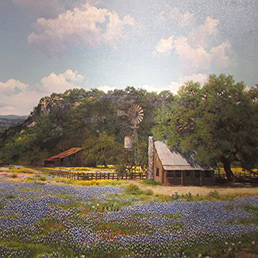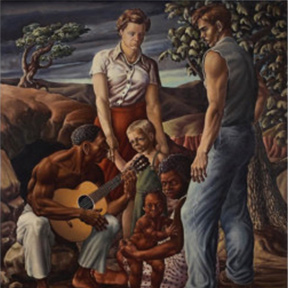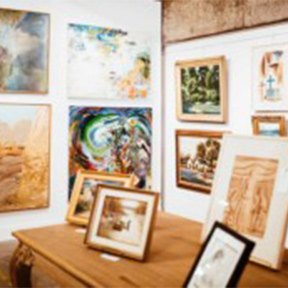- (214) 720-4044
- info@daviddike.com
- Mon - Fri: 10 am - 5 pm
Ladd, Sweetie
Sweetie Ladd
(Am. 1902-1991)
Sweetie Ladd was a sophisticated woman who deliberately chose the medium of folk art to preserve Fort Worth history and leavened that history with her own memories, her love of people and her special sense of humor.
Ladd took a light-hearted approach to her art. She once advised a fellow artist studying her folk art style to “just paint poorly, dear.” But she had a historian’s dedication to accuracy when it came to painting Fort Worth landmarks. She told a Fort Worth Star-Telegram reporter in 1976 that it wasn’t unusual for her to wake up in the middle of the night trying to remember whether the interurban did indeed stop in front of the building she was drawing or a block away.
She researched the history of buildings and events at the Fort Worth Public Library and often painted scenes from the library’s collection of historic Fort Worth photographs. What makes her work uniquely her own, however, is the people, clothing, animals, and details from her memory.
The Fort Worth Public Library owns probably the largest single collection of Sweetie Ladd works; fittingly the Central Library at 300 Taylor Street was built in part on land once occupied by the Ladd Furniture Company where Sweetie Ladd’s first artistic endeavor was illustrating furniture advertisements.
Ladd was not a native of the city she sought to preserve in art. She was born in Bonham, the fifth child of Edgar and Lou Kerr. One of her three sisters insisted that the baby be called Sweetie, “because she is so sweet.” She was named Ileta for legal documents, but family and friends always called her Sweetie and few were aware that she had a more formal name. As an artist, she regretted her name. “people think I’m not sophisticated,” she told a reporter.
The Kerr family moved to Fort Worth in 1905 when Sweetie’s father, rancher and cattleman Edgar Kerr, affiliated with the Cassidy Southwestern Commission Company. The Kerrs were “somewhat well-to-do,” the artist once recalled. “We had a nice home on Hemphill, and two horses and a surrey that we sold for an automobile as soon as they were available.”
Sweetie Ladd grew up in Fort Worth’s cattle heyday, when cattle barons were building homes along Summit Avenue and downtown buildings were not simply buildings but monuments to the builders. As a schoolgirl, Sweetie swan with her friends on Saturdays at the Turkish Baths in the rococo Natatorium Building, followed by ice cream sodas at Booth’s Confection. She had dates to see Eddie Cantor and Will Rogers at the Majestic Theater on Monday nights – “the society night.” Her parents made a concession to permit her to attend on Mondays, which were school nights, with her special beau, Homer Ladd, five years her senior. “I was kind of grown up,” Sweetie recalled.
She remembered dances at Lake Erie during her courtship with Homer Ladd. “We never rode the Interurban because Homer’s dad had a Studebaker. We complained that the Studebaker jarred your eye-teeth, she his dad bought a Franklin and we bounced in that.” Sweetie graduated from Fort Worth’s Central High School and received a degree from TCU, in English and Spanish, in 1932, after her marriage to Homer and the birth of their only child, Homer Ladd, Jr.
Although her paintings are classifies as folk art, Sweetie Ladd never fit the definition of self-taught artist. She was a sophisticated woman who traveled throughout the US and Europe. She was a charter member of the Woman’s Club of Fort Worth, Fort Worth Garden Club, and Woman’s Wednesday Club as well as a member of the Lecture Foundation. Both Sweetie and Homer were members of First Presbyterian Club of Fort Worth where her instructors included one of Texas’ leading painters, Bror Utter. Laster she took workshops taught by artist Frederic Taubes, who recognized her unique talent as a “primitive” artist and urged her to forego additional instruction and simply paint what she remembered. Ladd took his advice. For the rest of her long life, she concentrated on painting. She gave up teaching the nondenominational Rae Reimers Bible Class with its membership of prominent Fort Worth women – a post she held for forty years – to attend a class on perspective at TCU. She rose at six-thirty each morning to allow herself two hours for painting.
Her first paintings were a series, “Cries of Fort Worth,” inspired by Wheatley’s “Cries of London,” etchings of peddlers in late eighteenth-century London. Her work frequently was compared to the of Grandma Moses who painted primitive views of her New England childhood. A close friend of Ladd’s objected to the comparison: “Grandma Moses was a simple person; Sweetie Ladd is not.” Sweetie Ladd searched the dictionary and coined her own term for her work: “eclectic primitive.”
Although she became an artist late in life, Sweetie Ladd lived to see her work widely acclaimed. Her painting of a 1908 Sunday School picnic at the original Broadway Presbyterian Church was included in the “American Painters in Paris” exhibition in 1976 that was part of the French recognition of the American bicentennial.
In 1982, gallery owner Ron Hall gave Sweetie Ladd a one-person show at his Sundance Gallery in Fort Worth. All of the paintings, watercolors, and etchings at that time on permanent loan to the Fort Worth Public Library included in the show. “It sold out,” Hall remembers. “In addition to the interest in local settings, people responded to the affection with which she treated her themes.” Dr. Paula Tyler of Austin, who was director of Sundance Gallery at the time, pointed out that “One of the charms of Sweetie’s paintings is the humor and wit in it.” A Sweetie Ladd painting recently reproduced on the cover of the Southwestern Historical Quarterly is from the private collection of Paula Tyler and her husband, Dr. Ron C. Tyler.
Sweetie Ladd painted almost to the day of her death on April 26, 1991, at the age of eighty-nine. When her hand shook so that she could no longer master watercolor, she produced hand-colored engravings. Her husband, Homer William Ladd, died in 1978. Their only child, Homer William Ladd, Jr. died in 1997 and is buried in Mount Olivet Cemetery beside his parents.
Source: Sweetie Ladd’s Historical Fort Worth by Cissy Stewart Ladd





